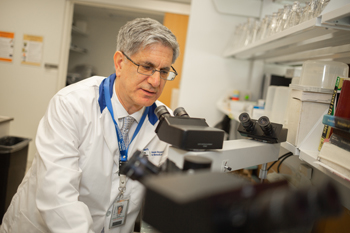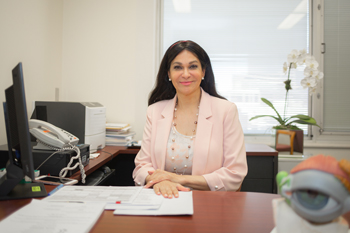No shortage of discoveries in sight

By Ana Gajic

Dr. Yeni Yucel (Photo by Yuri Markarov)
It’s said that the eyes are windows to the soul. But to Dr. Yeni Yucel, Dr. Neeru Gupta and their research team at the Keenan Research Centre for Biomedical Science (KRCBS), eyes are windows to our health.
A discovery at St. Michael’s Hospital nearly a decade ago has built a foundation of innovation in eye research. In 2009, Dr. Yucel and his team found that contrary to popular belief, the human eye has a lymphatic system. This system is responsible for clearing fluid and waste out of tissues. The inability to clear fluid from the eye causes a buildup of pressure, and pressure is the main cause of glaucoma.
“Since then, our contribution has been to look at the implications of this completely new system for eye health, vision and disease,” said Dr. Yucel, who is also a member of the Institute of Biomedical Engineering Science and Technology (iBEST) and a pathologist at St. Michael’s.
Most recently, in a paper published in early June, the team of researchers found that in vivo photoacoustic imaging – a technique that allows for very high-resolution imaging of a live model – can be used to measure fluid movement from inside the eye to the neck’s lymph nodes. This novel work proved that fluid from the eye drains at least in part to the larger lymphatic system, tying the eye to the larger fluid flow in the body.
Another study in late 2017 revealed a previously unknown pathway through which cerebrospinal fluid – the water around the brain – enters the optic nerve. This has added to the body of knowledge around the glymphatic system – the waste clearance pathway of the central nervous system – and has contributed a new perspective to glaucoma research.
Glaucoma is one of the world’s leading causes of irreversible blindness. Often undetected in its onset, once a patient receives the diagnosis, progressive vision loss is inevitable, although it can be slowed with treatments to lower pressure in the eye.

Dr. Neeru Gupta (Photo by Yuri Markarov)
“We really don’t know what causes glaucoma,” said Dr. Neeru Gupta, clinician-scientist at the KRCBS, and co-primary investigator of these studies. “We know there’s a problem with the drainage system of the eye and fluids not getting out. These discoveries open up a brand new window – now we can look at whether the problem in glaucoma is a lack of waste clearing, or an issue with this glymphatic system.”
Discoveries from the KRCBS will also help test the efficacy of new medications for diseases such as glaucoma, and look at other targets to treat the eye.
Dr. Yucel credits the researchers’ success to the culture of innovation at St. Michael’s Hospital. The establishment of novel technologies in the KRCBS has facilitated this work. Unique machines that show very precise and in-depth scans of eyes, such as photo-acoustic tomography, optical coherence tomography, near-infrared retinal funduscopy for eye imaging and near-infrared hyperspectral microscopy allow the team to study living eyes and models, and watch the glymphatic system in action. One machine in particular, the Multispectral Optoacoustic Tomography, is the only one of its kind in Canada. It beams safe laser pulses into living tissue, and this energy is absorbed and converted into heat, which is analyzed to produce highly precise images of the tissue.
“Good tools and equipment also attract the best students,” he said. “We have students from Ryerson through iBEST and we have students from the University of Toronto. We’ve created an organic environment for learning. It’s very stimulating, and often I feel like I’m learning just as much as the students.”
Because of the set-up of the lab, the technology is available for multiple teams. This has helped efficacy – when one team makes an error, they can inform other teams so it’s not repeated. Teams can also share data to enhance their work.
Ultimately, it makes the process of discovery more efficient, Dr. Yucel said, which will help bring new solutions to patients sooner.
“Everything we do has the patient at the centre,” said Dr. Gupta, director of the Glaucoma Unit at St. Michael’s, and a member of the Board of Directors of the World Glaucoma Association.
“There would be no excitement in any of this research if we didn’t feel it was deeply connected to the patients who sit in our exam rooms every day.”
About St. Michael’s Hospital
St. Michael’s Hospital provides compassionate care to all who enter its doors. The hospital also provides outstanding medical education to future health care professionals in more than 29 academic disciplines. Critical care and trauma, heart disease, neurosurgery, diabetes, cancer care, care of the homeless and global health are among the Hospital’s recognized areas of expertise. Through the Keenan Research Centre and the Li Ka Shing International Healthcare Education Centre, which make up the Li Ka Shing Knowledge Institute, research and education at St. Michael’s Hospital are recognized and make an impact around the world. Founded in 1892, the hospital is fully affiliated with the University of Toronto.
